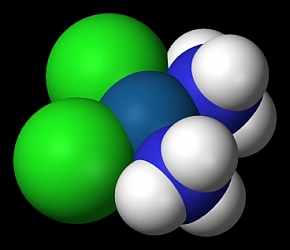Researchers at MIT in Cambridge, Massachusetts and Brigham and Women’s Hospital in Boston have shown that they can use nanotechnology to deliver the cancer drug cisplatin much more effectively and safely. Cisplatin (illustrated right) has been approved by the FDA as a treatment alone for bladder and ovarian cancer, and with other therapies for a number of other cancers, but has potentially severe side effects.
The research team — MIT chemistry professor Stephan Leppard, Shanta Dhar, a postdoctoral associate in Lippard’s lab, Omid Farokhzad who directs the nanomedicine lab at Brigham and Women’s Hospital, and Nagesh Kolishetti, a postdoctoral associate in Farokhzad’s lab — encapsulated cisplatin in a nanoparticle targeted to prostate tumor cells and activated the drug once it reached its target. Using these new particles, the researchers were able to successfully shrink tumors in mice, using only one-third the amount of conventional cisplatin needed to achieve the same effect.
Doctors began using cisplatin to treat cancer in the late 1970s. The drug destroys cancer cells by cross-linking their DNA, which ultimately triggers cell death. But cisplatin has serious side effects, notably kidney damage, nerve damage, and nausea.
Another problem with conventional cisplatin is its relatively short lifetime in the bloodstream. Only about 1 percent of the dose given to a patient ever reaches the tumor cells’ DNA, and about half of it is excreted within an hour of treatment.
To prolong the time in circulation, the researchers decided to encase a derivative of cisplatin in a water-repelling nanoparticle. This step enabled an inactive form of the drug — that usually attracts water — to be encapsulated in a nanoparticle.
Using this approach, much more of the drug reaches the tumor, because less of the drug is degraded in the bloodstream. The researchers found that the nanoparticles circulated in the bloodstream for about 24 hours, at least 5 times longer than un-encapsulated cisplatin. They also found that it did not accumulate as much in the kidneys as conventional cisplatin. To help the nanoparticles reach their target, the researchers also coated them with molecules that bind to prostate specific membrane antigen or PSMA, a protein found on most prostate cancer cells.
After showing the nanoparticles’ improved durability in the blood, the researchers tested their effectiveness by treating mice implanted with human prostate tumors. They found that the nanoparticles reduced tumor size as much as conventional cisplatin over 30 days, but with only 30 percent of the dose.
Read more: Research Institutes Collaborate on Cancer Nanomedicine
* * *


 RSS - Posts
RSS - Posts
[…] Read more: Nanotech Helps Reduce Cancer Drug Side Effects […]